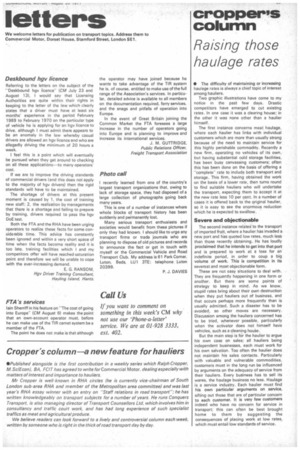cropper's column
Page 31

If you've noticed an error in this article please click here to report it so we can fix it.
Raising those haulage rates
• The difficulty of maintaining or increasing haulage rates is always a chief topic of interest among hauliers.
Two graphic illustrations have come to my notice in the past few days. Drastic competitors have emerged to cut existing rates. In one case it was a clearing house; in the other it was none other than a haulier himself.
The first instance concerns meat haulage, where each haulier has links with individual customers which are more than usually strong because of the need to maintain service for this highly perishable commodity. Recently a new firm, operating no vehicles of its own, but having substantial cold storage facilities, has been busy canvassing customers: often this has been done on the basis of offering a "complete" rate to include both transport and storage. This firm, having obtained the work on the basis of a lower rate, then turns round to find suitable hauliers who will undertake the transport, expecting them to accept it at the new rate less 10 per cent. In a number of cases it is offered back to the original haulier, so it is easy to see the enormous reduction which he is expected to swallow.
Severe and objectionable
The second instance relates:to the transport of imported fruit, where a haulier has invaded a new port and has quoted low rates, much less than those recently obtaining. He has loudly proclaimed that he intends to get into that port and is prepared to work at a loss for an indefinite period, in order to coup a big volume of work. This is competition in its severest and most objectionable form.
These are not easy situations to deal with. They are frequently happening in one form or another. But there are some points of strategy to keep in mind. As we know, stupid rates bring about their own destruction when they put hauliers out of business, and that occurs perhaps more frequently than is usually admitted. Such a disaster has to be avoided, so other moves are necessary. Discussion among the hauliers concerned has to be tried, whenever possible, particularly when the activator does not himself have vehicles: such as a cleaning houSe.
But the main step is for the haulier to argue his own case on sales: all hauliers being independent businesses, each must work for his own salvation. Too often the haulier does not maintain his sales contacts. Particularly with valuable and vulnerable commodities, customers must in the long run be influenced by arguments on the adequacy of service from their hauliers. Every business has to sell its wares, the haulage business no less. Haulage is a service industry. Each haulier must find his own particular arguments on service, sifting out those that are of particular concern to each customer. It is very few customers indeed who have no concern for service in transport; this can often be best brought home to them by suggesting the consequences of placing work at low rates, which must entail low standards of service.




















































































